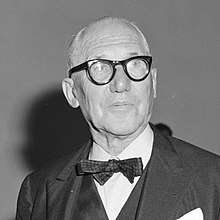
Back Le Corbusier Afrikaans Le Corbusier ALS Ле Корбюзье ALT ለ ኮርቡዝዬ Amharic Le Corbusier AN لو كوربوزييه Arabic لو كوربوزيي ARY لو كوربوزييه ARZ লী ক'ৰবাজিয়ে Assamese Le Corbusier AST
This article may be too long to read and navigate comfortably. When this tag was added, its readable prose size was 12,000 words. (September 2023) |
Le Corbusier | |
|---|---|
 Le Corbusier in 1964 | |
| Born | Charles-Édouard Jeanneret-Gris[1] 6 October 1887 La Chaux-de-Fonds, Neuchâtel, Switzerland |
| Died | 27 August 1965 (aged 77) Roquebrune-Cap-Martin, Alpes-Maritimes, France |
| Nationality | Swiss, French |
| Occupation | Architect |
| Awards |
|
| Buildings | Villa Savoye, Poissy Villa La Roche, Paris Unité d'habitation, Marseille Notre Dame du Haut, Ronchamp Buildings in Chandigarh, India |
| Projects | Ville Radieuse |
| Signature | |
Charles-Édouard Jeanneret (6 October 1887 – 27 August 1965), known as Le Corbusier (UK: /lə kɔːrˈbjuːzieɪ/ lə kor-BEW-zee-ay,[2] US: /lə ˌkɔːrbuːˈzjeɪ, -ˈsjeɪ/ lə KOR-boo-ZYAY, -SYAY,[3][4] French: [lə kɔʁbyzje]),[5] was a Swiss-French architect, designer, painter, urban planner and writer, who was one of the pioneers of what is now regarded as modern architecture. He was born in Switzerland and acquired French nationality by naturalization on 19 September 1930.[6] His career spanned five decades, in which he designed buildings in Europe, Japan, India, as well as North and South America.[7] He considered that "the roots of modern architecture are to be found in Viollet-le-Duc".[8]
Dedicated to providing better living conditions for the residents of crowded cities, Le Corbusier was influential in urban planning, and was a founding member of the Congrès International d'Architecture Moderne (CIAM). Le Corbusier prepared the master plan for the city of Chandigarh in India, and contributed specific designs for several buildings there, especially the government buildings.
On 17 July 2016, seventeen projects by Le Corbusier in seven countries were inscribed in the list of UNESCO World Heritage Sites as The Architectural Work of Le Corbusier, an Outstanding Contribution to the Modern Movement.[9]
Le Corbusier remains a controversial figure. Some of his urban planning ideas have been criticized for their indifference to pre-existing cultural sites, societal expression and equality, and his alleged ties with fascism, antisemitism, eugenics,[10] and the dictator Benito Mussolini have resulted in some continuing contention.[11][12][13][14]
Le Corbusier also designed well-known furniture such as the LC4 Chaise Lounge Chair, and the ALC-3001 chair, both made of leather with metal framing.
- ^ Ministère de la Culture et de la Communication, Archives nationales; site de Fontainebleau, Légion d'honneur recipient, birth certificate. Culture.gouv.fr. Retrieved on 27 February 2018.
- ^ "Le Corbusier". Lexico UK English Dictionary. Oxford University Press. Archived from the original on 26 January 2022.
- ^ "Le Corbusier". The American Heritage Dictionary of the English Language (5th ed.). HarperCollins. Retrieved 16 August 2019.
- ^ "Corbusier, Le". Merriam-Webster.com Dictionary. Retrieved 16 August 2019.
- ^ "Steve Rose on Le Corbusier, one of the most iconic architects of the 20th century". the Guardian. 16 July 2008. Retrieved 25 May 2021.
- ^ "Biographie de Le Corbusier - 1929-1938 : Le globe-trotter de l'architecture moderne". Fondation Le Corbusier (in French). Retrieved 22 November 2023.
- ^ Cite error: The named reference
:0was invoked but never defined (see the help page). - ^ Froissart, Rossella (2011). Avant-garde et tradition dans les arts du décor en France. Lectures critiques autour de Guillaume Janneau (PDF) (in French). Université de Provence - Aix-Marseille. p. 73.
- ^ "The Architectural Work of Le Corbusier, an Outstanding Contribution to the Modern Movement". Retrieved 14 October 2016.
- ^ López-Durán, Fabiola (11 December 2018). Eugenics in the Garden Transatlantic Architecture and the Crafting of Modernity By Fabiola López-Durán. University of Texas Press. ISBN 978-1-4773-1495-1. Archived from the original on 3 August 2022. Retrieved 3 August 2022.
- ^ "BBC Four – A History of Art in Three Colours, White". BBC. Retrieved 25 May 2021.
- ^ "The profound anti-Semitism of Le Corbusier". Haaretz. Retrieved 25 May 2021.
- ^ Donadio, Rachel (12 July 2015). "Le Corbusier's Architecture and His Politics Are Revisited". The New York Times. ISSN 0362-4331. Retrieved 25 May 2021.
- ^ Antliff, Mark, "Avant-Garde Fascism: The Mobilization of Myth, Art, and Culture in France, 1909–1939"
© MMXXIII Rich X Search. We shall prevail. All rights reserved. Rich X Search